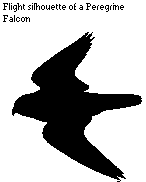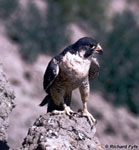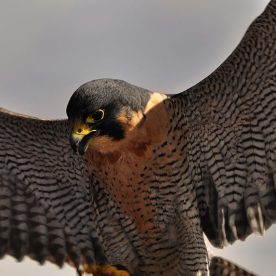Description

The Peregrine Falcon Falco peregrinus is a sturdy crow-sized falcon. Adult females are larger than males, measuring 45 to 59 cm and weighing about 910 g, compared with the males’ length of 36 to 49 cm and weight of about 570 g. The Peregrine’s most reliable distinguishing features are the blackish malar, or cheek, stripe below the eye and the dark bluish-grey or slate-coloured crown, back, and upper surface of the wings. The throat is white and the underparts are white to buff, with blackish brown bars on the sides, thighs, abdomen, underwings, and lower breast area. Young Peregrines have upperparts whose colour varies from pale to slate or chocolate brown and underparts that are buffy with blackish streaks.
Generally smaller and more streamlined than hawks, Peregrines, like all falcons, have small heads, firm compact plumage, and long pointed wings—adaptations that allow them to fly at great speed. In flight they use quick, powerful wing strokes. Their powerful talons and strong hooked beak, equipped with a notch or “tooth” that aids in severing the spinal cord of avian prey, mark them as highly specialized predators.
Some Peregrines have lived 18 to 20 years, but the average life span is much shorter.
Traditionally, the female has been known as the “falcon” and the male as the “tercel.”
Signs and sounds
Peregrines become excited and sometimes aggressive when humans approach their nests, particularly if young are present. Aggressive birds may dive within a metre of intruders or even strike them, screaming a high-pitched cack-cack-cack. Because the calls often intensify the nearer someone gets to the nest, the Peregrine may unknowingly aid rather than intimidate the nest seeker. Although similar, the voices of the two sexes can be distinguished: the male’s is more wheezy and high-pitched, while the female’s is grating and more coarse.
Habitat and Habits
Peregrines nest mostly on steep cliffs. In fact, an extraordinary feature of these birds is their traditional use of certain ledges for nesting. For example, successive pairs have nested on the same ledges on the island of Lundy, off the southwest coast of England, since at least 1243. In remote, relatively undisturbed areas such as the Canadian Arctic, they also choose steep slopes, river cutbanks, and even low rocks and mounds. In North America, they rarely nest on flat ground or in trees, but such sites are more common in other parts of their range. Ground- or bog-nesting occur in northern Finland, for example, and tree-nesting is taking in place in Germany following recent reintroductions of Peregrines where the populations had vanished.
A departure from the tradition of nesting on cliffs is the Peregrine’s use of tall buildings. One of the most famous of such birds was Scarlet, a female that appeared as a yearling in 1937 outside the twentieth floor of the Sun Life headquarters building in Montreal. An aggressive bird, she remained for 16 breeding seasons, had three successive mates, and reared 21 young. Her breeding record remained unmatched in the annals of bird study until 2003, when a female named Meg, in St. Paul, Minnesota, had bred for 16 consecutive years, had six different mates, and produced 43 young. Some more recent city nestings, a direct result of the introduction of captive-raised falcons, have taken place in Edmonton, Red Deer, Calgary, Saskatoon, Regina, Brandon, Winnipeg, London, Toronto, Ottawa, Montreal, Quebec City, and Saint John.
Unique characteristics
The Peregrine Falcon has been the favourite of falconers for over 3 000 years, ever since the nomads of central Asia first pursued game with trained hawks and falcons.
Extremely acute eyesight, even in dim light, allows falcons to be very effective hunters around dawn and dusk.
Peregrines often migrate very rapidly between breeding and wintering areas, flying as much as 500 km per day. A female Peregrine that nested in Edmonton flew to Mazatlan, Mexico, in less than eight days and returned in six days.
Range

With the exception of Antarctica, New Zealand, and Iceland, the Peregrine is found around the globe. Twenty-two subspecies are recognized throughout the world. Their great powers of flight have enabled them to establish nesting populations in the Arctic, and as far south as Tasmania, South Africa, and the Falkland Islands.
Three subspecies of Peregrines nest in North America: the pealei subspecies Falco peregrinus pealei, the anatum subspecies Falco peregrinus anatum, and the tundrius subspecies Falco peregrinus tundrius. Members of the pealei subspecies are large dark birds that nest on the coast of Alaska and British Columbia, mostly resident or only slightly migratory. Members of the anatum subspecies are medium-sized and richly pigmented with buffy salmon on the breast; they often have black cheeks. They nest south of the tree line throughout the remainder of continental North America, excluding parts of the central United States from North Dakota to Texas and Louisiana. They are migratory in northern areas and resident farther south. Members of the tundrius subspecies are smaller, paler on the breast, and highly migratory arctic birds.
Peregrines banded in the Northwest Territories have been recovered in Argentina; most arctic nesters apparently “leapfrog” more southern North American falcons to winter farther south in South America. In fact, the Peregrine Falcon was named for the lengthy migrations of some populations: “peregrine,” from the Latin adjective peregrinus, means “coming from foreign parts” or “wanderer.”
Feeding
Peregrines’ prey species vary greatly from region to region and even from one nesting site to the next. For example, in parts of the Queen Charlotte Islands, British Columbia, Peregrines feed almost entirely on the Ancient Murrelet, a small seabird plentiful there. On the east coast of Labrador, Peregrines eat Black Guillemots, another common seabird, and small mammals such as mice and voles. At Rankin Inlet, on the west shore of Hudson Bay, Peregrines eat mostly lemmings and shorebirds. In southern Canada, they eat a variety of birds that live in wetlands, including Franklin’s Gulls, Black Terns, Lesser Yellowlegs, Eared Grebes, Northern Flickers, Green-winged Teals, and Soras. In cities, Peregrines eat some pigeons, but these rarely account for more than 20 percent of their diet.
The Peregrine’s speed and size make it an excellent hunter, able to prey on some of the larger birds. This long-winged raptor specializes in direct pursuit in the open. As a result, it favours non-forested areas, particularly shores, marshes, river valleys, open moors, and tundra. Even though its level speed of flight exceeds that of most birds, the Peregrine usually takes advantage of height when attacking. When it stoops, or dives, at prey, it can reach speeds of over 300 km per hour.
A stooping Peregrine is a hurtling wedge of streamlined feathers. Its feet lie back against its tail and its wings are half closed. Its usual method of disabling or killing medium-sized and large prey is to deliver a fierce blow with a half-closed foot during a dive. If the quarry is too heavy to carry, the Peregrine allows it to fall to the ground, then lands to kill and feed on it. It snatches small prey such as swallows or sandpipers in mid-flight with its talons or strikes the prey down and then retrieves it. The Peregrine’s flights at intended prey are often unsuccessful. The ability of the individual bird, the agility of the prey, and the availability of escape cover affect the success of each stoop. As is usual in predator–prey relationships, the Peregrine singles out aberrant or weaker individuals as prey.
Breeding

Peregrines reach sexual maturity at about two years of age. They are territorial during the breeding season. Even in areas where nests are most numerous, nesting pairs are usually more than 1 km, and often much farther, apart. This ensures adequate food for all nesting pairs and their offspring. They defend the immediate nest site against other Peregrines, and often against eagles or ravens. Within a breeding territory of several square kilometres, a Peregrine pair may have a number of alternative nesting ledges. In a 16-year period, a pair or its successors may use up to seven ledges.
Most cliff nests are on ledges with vegetation and under an overhang. Sites with a southerly exposure are generally favoured. Females scrape a shallow hollow (usually in the loose soil, sand, gravel, or dead vegetation on cliff ledges) in which to lay their eggs. They add no nest materials.
Peregrines nesting in the north arrive on the breeding grounds later than those nesting farther south, and they begin to lay their eggs later than their southern counterparts. After an early to mid-April arrival, the male courts his larger mate with aerobatics and loud repeated calls. In early to mid-May, the female lays three or four mottled brick-red or mahogany-coloured eggs, one every second day. Both adults incubate, or warm, the eggs until they hatch. Incubation begins when the last or second-to-last egg is laid and continues for about 32 days. Re-nesting following loss of the first clutch, or set of eggs, is rare in the Arctic owing to the short summer season, but is common farther south. On average only one or two nestlings (eyasses) live long enough to fledge, or fly, from each nest, as a result of some infertile eggs and natural losses.
Newly hatched eyasses are awkward bundles of creamy white down with disproportionately large feet. At about three weeks, the first contour feathers appear on the wings and tail and around the eyes, and by about three weeks later, feathering is complete, when the birds are about 40 days old. The young spend 35 to 45 days in the nest; males usually make their first flights when a few days younger than females. Eyasses are fed regularly by both parents, who pluck the feathers from the prey at a nearby plucking perch before taking the food to the nest. When the nestlings begin to fly, the parents fly past with prey in their talons and the young attempt to snatch it from them in mid-air. After several weeks of such instruction, the young begin to catch their own prey.
The young Peregrines wear juvenile plumage for a year, with only slight changes due to wear and fading. Adults moult and replace the wing feathers, one at a time, during the summer.
Conservation
Peregrine Falcon populations were long noted for their stability. In Great Britain, for example, where a host of birdwatchers and falconers studied Peregrines, the breeding population of some 600 pairs changed little from Elizabethan days (the 16th century) until the 1940s. During the Second World War, Peregrines were eliminated in some areas to protect homing pigeons. Although these populations recovered after the war, from about 1945 onward, many once-vigorous Peregrine populations suffered widespread, unprecedented declines, particularly in Europe and North America. In the eastern United States, where at least 300 nests were once known, Peregrines were nearly extinct by the 1960s.
A decline of such rapidity, magnitude, and distribution at first puzzled ornithologists. Direct human intervention, such as nest robbing, trapping, or shooting, was ruled out as the primary cause, as Peregrines had been subjected to these onslaughts for hundreds of years. Research studies strongly suggested that persistent chemical pesticides or industrial pollutants were the major cause of the decline. Not only did the Peregrine decline correspond closely in its timing and geographical extent with intensive post-war use of pesticides, but high pesticide residue levels were found in the birds and their eggs.
With few enemies and a long lifespan, Peregrines, like other predators, are at the top of a food chain. Because they ate birds that may have eaten grain or insects treated with pesticides, the Peregrines were exposed to much higher levels of pesticide residues than were found in the air or water. Pesticide residue levels in their bodies would have been many times higher than the levels in their prey species. At high levels, these chemicals caused reproductive failure by interfering with breeding behaviour, eggshell formation, and hatching success. Thus Peregrine populations gradually dwindled because of the lack of breeding success.
In 1969 in Canada and in 1972 in the United States, restrictions were placed on the use of DDT, a persistent pesticide that contributed to the Peregrine’s decline. Nevertheless, Canadian Peregrines and their prey species probably continued acquiring contaminants on their wintering grounds in Central and South America.
Peregrine Falcons, like virtually all birds of prey, now receive legal protection in most parts of North America. In other parts of the world, however, protection is much less complete, and populations are endangered by adults being shot and young being taken from nests.
The Committee on the Status of Endangered Wildlife in Canada designated the anatum subspecies as “endangered” in 1978. Recovery efforts that included captive breeding and reintroduction improved the subspecies’ status, and in 2000, the designation was changed to “threatened.” Similarly, the tundrius subspecies’ “threatened” designation, assigned in 1978, was changed to “special concern” in 1992. The pealei subspecies has been designated a species of “special concern.” The three subspecies are listed under the federal Species at Risk Act.
Since 1974, more than 1 650 Peregrines have been bred in captivity at the Canadian Wildlife Service breeding facility at Wainwright, Alberta, at university-based facilities in Saskatchewan and Quebec, and at a private facility in Alberta. Staff from wildlife agencies and non-profit organizations have released the captive-raised birds from natural cliffs and tall buildings at over 60 sites from southern Alberta to the Bay of Fundy on Canada’s east coast. In 2005, there were more than 200 pairs of wild Peregrines breeding in southern Canada and more than 300 wild pairs in Yukon and the Mackenzie valley. Over 7 000 pairs of Peregrines are now thought to breed in North America, including Mexico.
Resources
Online resources
Species at Risk Registry, Peregrine Falcon anatum/tundrius
Species at Risk Registry, Peregrine Falcon pealei subspecies
Species at Risk Registry, Peregrine Falcon tundrius subspecies
All About Birds, Peregrine Falcon
Audubon Field Guide, Peregrine Falcon
Government of Ontario, Peregrine Falcon
Print resources
Banasch, U., and G. Holroyd. 2004. The 1995 Peregrine Falcon survey in Canada. Occasional Paper No. 110. Canadian Wildlife Service, Ottawa.
Craig, G.R., and J.H. Enderson. 2004. Peregrine Falcon biology and management in Colorado 1973–2001. Technical Publication No. 43. Colorado Division of Wildlife, Fort Collins, Colorado.
Enderson, J.H., W. Heinrich, L. Kiff, and C.M. White. 1995. Population changes in North American Peregrines. Transactions of the 60th North American Wildlife and Natural Resources Conference, 142–161.
Rowell, P., G.L. Holroyd, and U. Banasch. 2003. The 2000 Canadian Peregrine Falcon survey. Journal of Raptor Research 37(2):98-116.
© Her Majesty the Queen in Right of Canada, represented by the Minister of the Environment, 1985, 1988, 1990, 1996, 2001, 2007. All rights reserved.
© Her Majesty the Queen in Right of Canada, represented by the Minister of the Environment, 1985, 1988, 1990, 1996, 2001. All rights reserved.
Catalogue number CW69-4/32-2001E
ISBN 0-662-30087-4
Text: Don Blood
Revision: U. Banasch, 2001, 2006
Photos: Gordon Court
Photo: R. Fyfe









